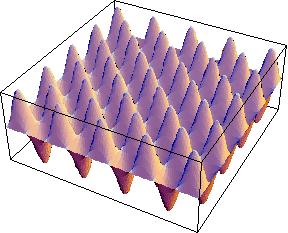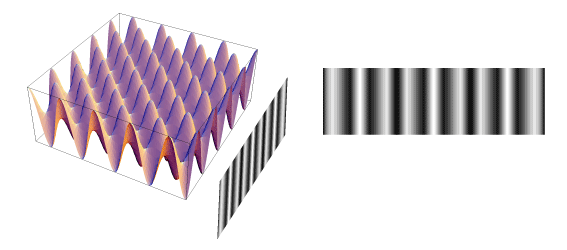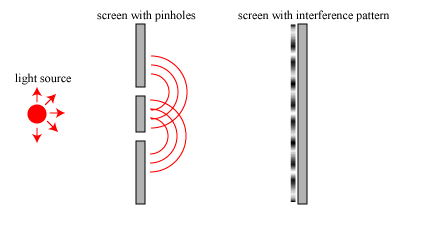In the first part of my series on ‘What is a wave?’, I attempted to give a broad definition of a wave, so that we can identify them when we see them. In this part, I will address two of the most important behaviors of waves: interference and diffraction. Interference may be loosely described as the interaction of a wave with itself, or a wave with another wave, while diffraction may be loosely described as the interaction of a wave with other objects.
We will discuss interference in this post, and consider again the wave on a string discussed in part I of this post. A pair of waves are sent down the string to a fixed end, where they are reflected and return to their point of origin. What happens when the waves pass each other? An animation of such an event is displayed below:

When the two waves pass one another, they combine in a non-obvious way. Two moments in time are of particular interest. When the leading edges of the two waves start to pass one another, they cancel each other out. The downward displacement of the left-going wave is completely canceled by the upward displacement of the right-going wave, leaving a region of no net string displacement:

The two waves are said to interfere with one another; the opposite vertical displacements of the pair of waves cancel each other out at that instant in time. This cancellation of the waves is referred to as destructive interference. Mathematically, it can be said that waves on a string satisfy a linear superposition principle: that is, to find the total amplitude (vertical displacement) of multiple interfering waves on a string, simply add the amplitudes of the individual waves. It’s worth mentioning that there are waves that do not satisfy linear superposition, and we’ll come back to such waves in a later post, but for now we note that most wave phenomena (string waves, water waves, light waves, acoustic waves) under ‘ordinary’ circumstances satisfy linear superposition.
If we let our field evolve a little further and take another snapshot, we encounter a slightly different circumstance:

Now the peaks (maxima) and troughs (minima) of the two waves coincide, so the two waves reinforce one another, creating in this case a wave that has twice the height of each individual wave. This is referred to as constructive interference. The dashed lines have been placed in the figures to demonstrate the concidence of the peaks and troughs.
Interference is a universal feature of wave behavior, and can be seen in two-dimensional wave systems such as water waves and three dimensional wave systems such as acoustic waves and light waves. For instance, let us look at a simulation of two water waves (specifically plane waves, which we’ll introduce in more detail later) and a snapshot of their combined amplitude:

The two individual patterns of water waves have combined and interfered to produce a new pattern. When the peaks or troughs of the individual waves coincide, they combine to produce a wave of larger amplitude. When a peak of one wave coincides with the trough of another, the waves cancel each other out. The combined pattern ‘splits the difference’ in direction overall and flows along a direction directly between the individual wave directions, as seen in this animation:

An interesting thing is to be noted from this video. Even though the entire pattern is always moving, there exist lines along which there is never any wave amplitude. The easiest to see is the line that forms the boundary of the wave closest to the viewer. If a tiny boat was sailing along this line in the water, the passengers would feel no waves and wouldn’t get seasick! Along this line, and others like it, we have complete destructive interference.
Water waves and waves on a string move and oscillate relatively slowly. We can readily observe with the naked eye the individual ‘ups and downs’ of the wave. For sound waves, however, and especially for light waves, the ‘ups and downs’ come much too rapidly for our senses to detect — the frequency of oscillation of a light wave for visible light is roughly 1 million-billion ‘ups and downs’ (cycles) per second! In such cases, we can only detect the average strength of the wave at any particular point in space. For light, this average wave strength is directly related to the intensity, or brightness, of the light. If we look at the intensity produced by our two-dimensional wave pattern above, it would be a series of bright and dark lines:

On the left we show you the pattern in its proper place, at the rightmost end of the ‘wave box’. On the right we reproduce the intensity pattern as it would look head on. In optics, such patterns of alternating bright and dark spots a light field are characteristic of interfering light fields; such a pattern is called an interference pattern.
Interference finds practical application in a number of wave phenomena, most notably acoustics and optics. Air travelers now frequently wear noise-cancelling headphones, which use destructive interference to cancel out unwanted background noise, as illustrated schematically below:

It is actually quite difficult to observe the wave properties of light. We will discuss the reasons for this in another post, but suffice to say for now that one must set up very precise experimental conditions to observe wave behavior of light. The classic experiment to directly demonstrate it is an interference experiment, now known as Young’s two-pinhole experiment or Young’s double slit experiment.
The basic idea is illustrated below. Light is shined upon a pair of small holes in an otherwise opaque screen. The light emanating from the holes spreads out via the mechanism of diffraction, to be discussed later. When the light fields from the two pinholes overlap, an interference pattern is created, and this pattern can be observed on a second screen placed in the path of the light fields.

What does the interference pattern look like? It looks essentially the same as the pattern produced by the pair of plane waves we showed earlier! Any time one interferes a pair of simple waves, be they plane waves or spherical waves from a pair of pinholes, the interference pattern takes on the form of alternating bright and dark bands of light.
Young’s experiment is interesting enough that we’ll discuss it in much more detail in a later post. Suffice it to say that modifications of the experiment have been used, and are still used, to explore new physics.
This concludes our non-technical description of interference. Next we’ll tackle diffraction, and then we’ll conclude our ‘What is a wave?’ series with a discussion of some of the mathematical quantities associated with waves.


Pingback: Optics basics: What is a wave? Part III: Diffraction « Skulls in the Stars
Though it is now some years after your post, there are some misunderstandings perpetuated in your presentation. If you dissect the relations of the tensions in the string in the example of the destructively interfering waves on a string, rather than passing through each other the waves reflect from each other. In fact, reflection between out of phase waves is a universal phenomenon. Based on careful examination of conservation of energy, one could conclude that destructively interfering waves do not cancel. They only exchange momentum.
.j